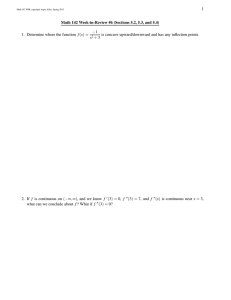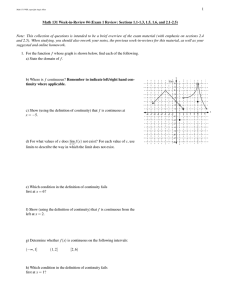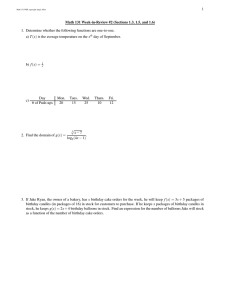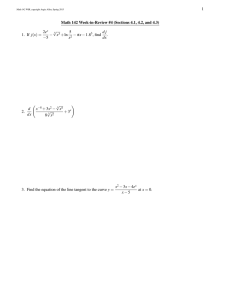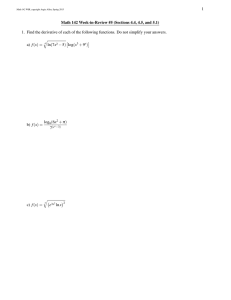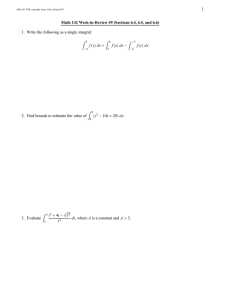1 1. Which, if any, of the following functions have an... f g
advertisement
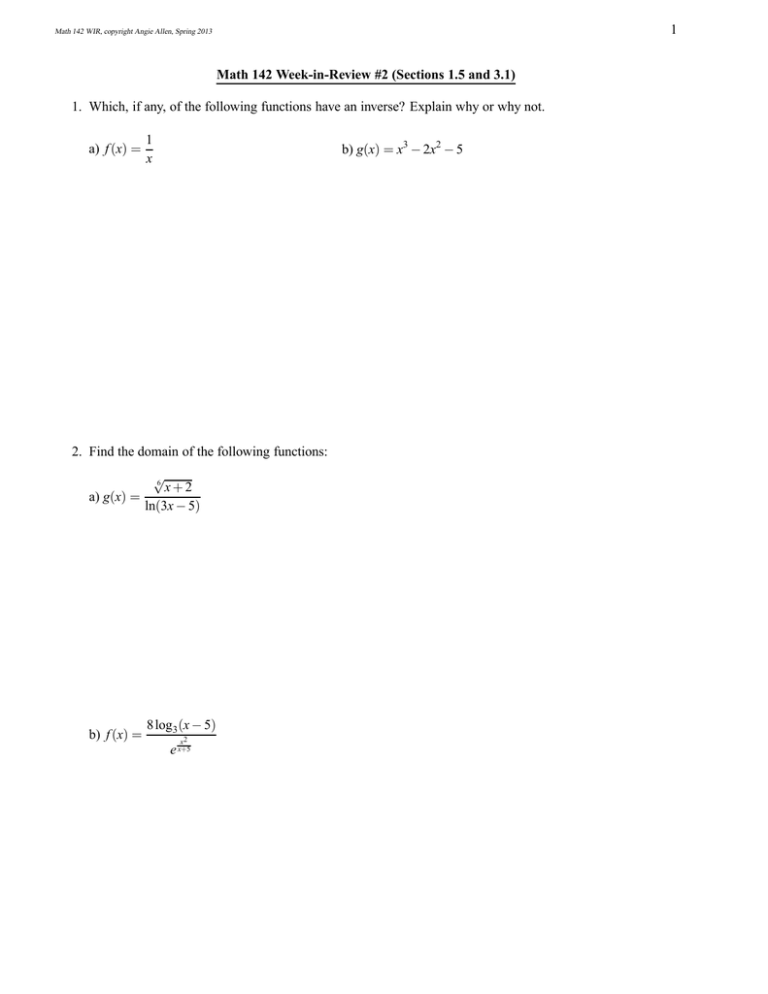
1 Math 142 WIR, copyright Angie Allen, Spring 2013 Math 142 Week-in-Review #2 (Sections 1.5 and 3.1) 1. Which, if any, of the following functions have an inverse? Explain why or why not. a) f (x) = 1 x b) g(x) = x3 − 2x2 − 5 2. Find the domain of the following functions: √ 6 a) g(x) = x+2 ln(3x − 5) b) f (x) = 8 log3 (x − 5) x2 e x+5 2 Math 142 WIR, copyright Angie Allen, Spring 2013 3. Evaluate the following limits numerically, if they exist. If a limit does not exist, use limits to describe the way in which it does not exist. a) lim (x2 − 5) x→−4 b) lim x→3 1 x−3 4. If logb 4 = 1.2619 and logb 6 = 1.6310, find logb 16 . 6b2 Math 142 WIR, copyright Angie Allen, Spring 2013 x2 − 7x + 1 , if it exists. If it does not exist, use limits to describe the way in which it does not x→3 (x − 3)2 5. Evaluate lim exist. 3 6. Solve the following for x: a) log3 (x + 5) = log10 100 − log3 (x − 5) b) 8 1.045x+1 = 24 c) 23 loga 25 − 2 loga 5 = loga x, where a > 0 and a 6= 1. Math 142 WIR, copyright Angie Allen, Spring 2013 4 d) log8 (x + 3) = log8 5 + log8 (x − 1) x2 + 8x + 15 , if it exists. If it does not exist, use limits to describe the way in which it does x→−5 x2 + x − 20 7. Evaluate lim not exist. x−1 , if it exists. If it does not exist, use limits to describe the way in which it does not x→1 (x − 1)2 8. Evaluate lim exist. 5 Math 142 WIR, copyright Angie Allen, Spring 2013 9. Consider the function f (x) below and answer the following questions: a) Find lim f (x), if it exists. x→−3 y 8 7 6 5 b) Find f (1), if it exists. 4 3 2 c) Find lim f (x), if it exists. x→1 1 −8 −7 −6 −5 −4 −3 −2 −1 1 −1 −2 −3 −4 −5 −6 −7 −8 d) Find f (2), if it exists. e) Find lim+ f (x), if it exists. x→2 f) State, using the definition of continuity, why f is not continuous at x = −3. g) State, using the definition of continuity, why f is not continuous at x = 1. 2 3 4 5 6 7 8 x 6 Math 142 WIR, copyright Angie Allen, Spring 2013 10. Evaluate lim x→13 exist. √ x+3−4 , if it exists. If it does not exist, use limits to describe the way in which it does not x − 13 11. Determine where the function f (x) = 5 ln(x − 3) √ is continuous. x+7 12. How long (in years) will it take a piece of equipment to be worth half of its current value if it is depreciating at a relative rate of 5.6% per year? 7 Math 142 WIR, copyright Angie Allen, Spring 2013 x2 − 9 , if it exists. If it does not exist, use limits to describe the way in which it does not exist. x→3 |x − 3| 13. Evaluate lim 14. For the function f (x) = x−1 , find lim h→0 the way in which it does not exist. f (4 + h) − f (4) , if it exists. If it does not exist, use limits to describe h 8 Math 142 WIR, copyright Angie Allen, Spring 2013 15. Consider the function f (x) below and answer the following questions: a) Find f (3), if it exists. b) Find f (−2), if it exists. c) Find lim f (x), if it exists. x→0 d) Find lim− f (x), if it exists. x→3 e) Find lim f (x), if it exists. x→−2 f) Determine where f (x) is continuous using the definition of continuity. 10x − 4x2 x+1 2 f (x) = x + 4x + 3 2 x −8 6 · 23−x x < −2 −2 < x ≤ 3 x>3 9 Math 142 WIR, copyright Angie Allen, Spring 2013 16. Simplify the following using properties of logarithms: 1 3 log7 x − 2 log7 y + log7 z + 4 log7 75 3 17. Find the value of A such that the function f (x) below is continuous for all real numbers x. f (x) = x 3e x < −2 Ax2 + x + 1 x ≥ −2
